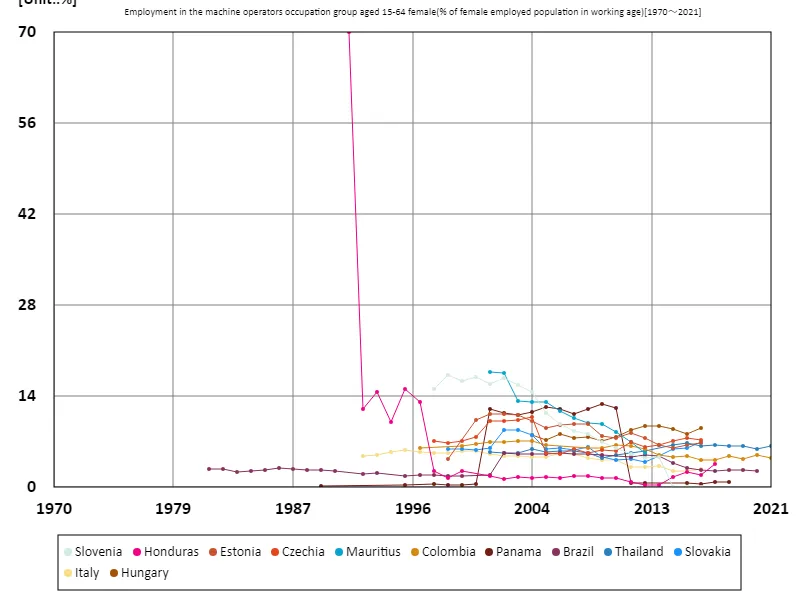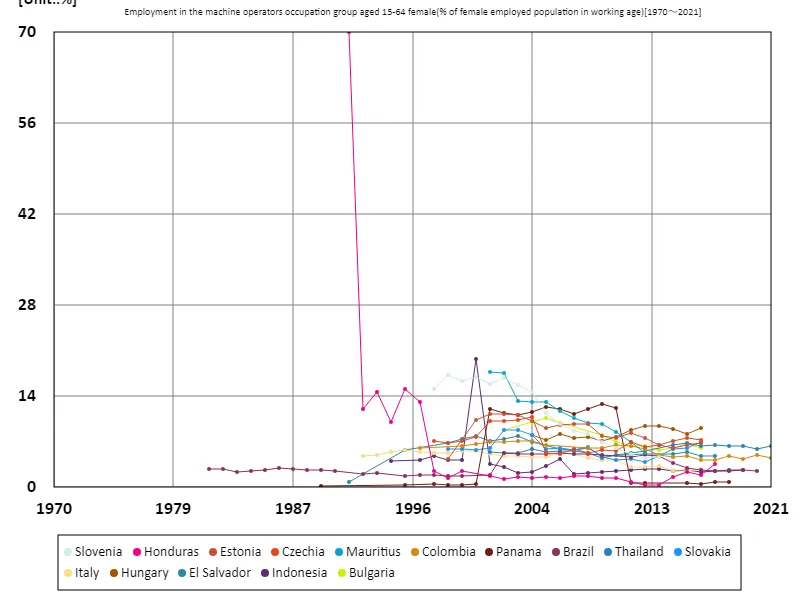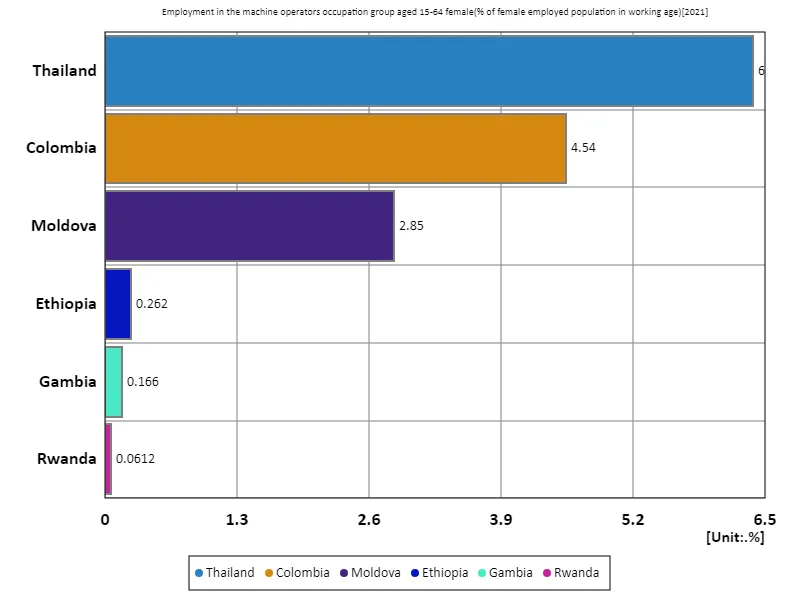- Abstract
- Employment rate of machine operators among women aged 15-64 (percentage of working-age female employed population)
- Employment rate of machine operators among women aged 15-64 (percentage of working-age female employment population) (Worldwide)
- Employment rate of machine operators among women aged 15-64 (percentage of working-age female employment in the labour force) (World, latest year)
- Reference
Abstract
According to 2021 data, the employment rate of machine operators among women aged 15-64 in Thailand is 6.38%, the highest figure. This trend suggests that Thailand’s manufacturing and industrial sectors are relatively thriving, leading to increased female participation in the labor market. As Thailand’s economy develops and industrialization progresses, many manufacturing and machinery operation jobs are being created, and it is believed that opportunities for women to take up these jobs are increasing. On the other hand, the higher proportion of women working as machine operators compared to other countries may suggest that Thailand’s labor market may be biased towards certain industries. For example, in other developing countries, education and technology may be less prevalent, meaning there are fewer women working in machinery operations. Additionally, in developed countries, the rise of automation in technical jobs and specialist occupations has led to lower employment rates for women as machine operators. Thailand’s high figure likely reflects the characteristics of its economic structure and changes in the regional labor market.
Employment rate of machine operators among women aged 15-64 (percentage of working-age female employed population)
Looking at data from 1981 to 2021, Honduras’ peak employment rate for women aged 15-64 as machine operators in 1991, at 69.9%, may have reflected the economic structure and increasing industrialization at the time. Honduras’ high employment rate suggests the importance of manufacturing at the time and the active participation of women in the labor market. However, recent data shows that this ratio has decreased to 5.19%. This shift likely reflects major changes in the structure of manufacturing due to technological advances, increased automation, and changing economies. Furthermore, Honduras’ economic challenges and the impact of global industrial relocation cannot be ignored. The decline in employment rates for female machine operators may be due to several factors, including a decline in manufacturing and a shift to other industries, or changes in education and skills. Fluctuations in the labor market in response to changes in the economic structure have a direct impact on female employment rates.


The maximum is 69.9%[1991] of Honduras, and the current value is about 5.19%
Employment rate of machine operators among women aged 15-64 (percentage of working-age female employment population) (Worldwide)
Based on data from 1981 to 2021, Honduras recorded a notable peak in employment of machine operators among women ages 15-64 in 1991, at 69.9%. This marks a time when Honduras’ economy was dependent on manufacturing and women were active as machine operators. This high employment rate was achieved because at the time, Honduras’ manufacturing industry was growing and many women were working as machine operators. However, in recent years, this percentage has fallen to 5.19%. This significant decline reflects changes in the structure of the economy, the contraction of manufacturing, and the impact of automation due to technological change. In recent years, the global economic environment has seen a trend toward overseas relocation of manufacturing and diversification of industries, and Honduras is no exception. This has likely led to a labour market shift away from traditional manufacturing to other industries, resulting in a decline in women’s employment as machine operators. Thus, economic changes and technological advances are having a major impact on women’s role in the labor market.


The maximum is 69.9%[1991] of Honduras, and the current value is about 5.19%
Employment rate of machine operators among women aged 15-64 (percentage of working-age female employment in the labour force) (World, latest year)
Based on 2021 data, Thailand recorded the highest employment rate of machine operators for women aged 15-64 at 6.38%. This indicates that Thailand’s manufacturing industry is thriving and women are widely employed as machine operators. Thailand’s economy is highly industrialized, reflected by the relatively high participation of women in the manufacturing sector. However, the overall employment rate is only 2.38%, indicating that in many countries, women are relatively underemployed in machine operator roles. This low average is thought to be due to factors such as the automation of manufacturing and the development of the service industry in developed countries, and a lack of education and technology in developing countries. Countries where manufacturing remains a major industry tend to have a higher proportion of women working as machine operators. While women still make up a steady share of overall employment as machine operators, as the combined employment rate of 14.3% indicates, their share is declining as the role of manufacturing shrinks in many countries. These trends reflect the impact of changes in the economic structure and technological advances on the women’s labor market, and are likely to fluctuate in the future depending on various factors.


The maximum is 6.38% of Thailand, the average is 2.38%, and the total is 14.3%



Comments